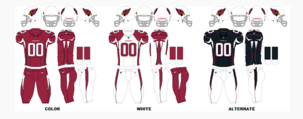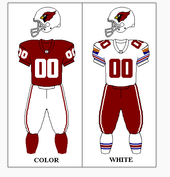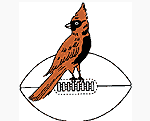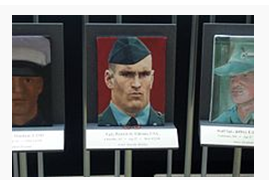
| Current season | |||
|
Established 1898 Play in University of Phoenix Stadium Glendale, Arizona Headquartered in Tempe, Arizona |
|||
|
|||
| League/conference affiliations | |||
|
National Football League (1920–present) Western Division (1933–1949) American Conference (1950–1952) Eastern Conference (1953–1969) Century Division (1967–1969) National Football Conference (1970–present) NFC East (1970–2001) NFC West (2002–present) |
|||
| Current uniform | |||
 |
|||
| Team colors |
Cardinal, White, Black |
||
| Mascot | Big Red | ||
| Personnel | |||
| Owner(s) | Bill Bidwill | ||
| Chairman | Bill Bidwill | ||
| President | Michael Bidwill | ||
| General manager | Steve Keim | ||
| Head coach | Bruce Arians | ||
| Team history | |||
|
Morgan Athletic Club (1898–1919) Chicago Cardinals (1920–1943) Card-Pitt (1944) Chicago Cardinals (1945–1959) St. Louis Cardinals (1960–1987) Phoenix Cardinals (1988–1993) Arizona Cardinals (1994–present) |
|||
| Team nicknames | |||
| The Cards, The Birds, Big Red, The Buzzsaw, Cardiac Cards, Bird Gang | |||
| Championships | |||
|
League championships (2) NFL Championships (pre-1970 AFL–NFL merger) (2) 1925, 1947 |
|||
|
Conference championships (1) NFC: 2008 |
|||
|
Division championships (6) NFL West: 1947, 1948 NFC East: 1974, 1975 NFC West: 2008, 2009 |
|||
| Playoff appearances (8) | |||
| *NFL: 1947, 1948, 1974, 1975, 1982, 1998,2008, 2009 | |||
| Home fields | |||
|
Since 1920 Normal Park (1920 –1921), (1926–1928) Comiskey Park (1922–1925), (1929–1958) Soldier Field (1959 4 games) Metropolitan Stadium (1959 2 games) Busch Stadium (1960–1965) Busch Memorial Stadium (1966–1987) Sun Devil Stadium (1988–2005) University of Phoenix Stadium (2006–present) |
|||
The Arizona Cardinals are a professional American football team. They are currently members of the Western Division of the National Football Conference (NFC) in the National Football League(NFL). The Cardinals were founded in 1898, and are the oldest continuously run professional American football club in the United States.[1]
The team was established in Chicago in 1898 and was a charter member of the NFL in 1920. Along with the Chicago Bears, the club is one of two NFL charter member franchises still in operation since the league's founding. (The Green Bay Packers were an independent team until they joined the NFL in 1921). The club then moved to St. Louis, Missouri in 1960 and played in that city through1987 (sometimes referred to as the "Football Cardinals" and / or the "Big Red" to avoid confusion with the Major League Baseball St. Louis Cardinals). Other less commonly used nicknames were the "Gridbirds" (used only by a local newspaper columnist) or "Cardiac Cards" (used only to refer to the 1975 team). Before the 1988 NFL season, the team moved to Tempe, Arizona, a college town suburb of Phoenix, and played their home games for the next 18 years at Arizona State University's Sun Devil Stadium. In 2006, the club began playing all home games at the newly constructedUniversity of Phoenix Stadium in the northwestern suburb of Glendale.
The franchise has two NFL championships, both while it was based in Chicago. The first occurred in 1925, but is the subject of controversy, with supporters of the Pottsville Maroons believing that Pottsville should have gotten the title. Their second title, and the first to be received through a championship game, came in 1947, two decades before the first Super Bowl game was played.
In the six-plus decades since winning the championship in 1947, the team suffered many losing seasons, and currently hold the league's longest active championship drought. They have been to the playoffs six times and have won six playoff games, three of which were victories during their run in the 2008-09 NFL Playoffs. During that season, they won their only NFC Championship Game since the 1970 AFL-NFL Merger, and reached Super Bowl XLIII. The team has also won four division titles (1974, 1975, 2008, and 2009) since their 1947–1948 NFL championship game appearances.
The Cardinals conduct their annual summer training camp at Northern Arizona University in Flagstaff.
Franchise history
Main article: History of the Arizona Cardinals
Logo and uniforms

Phoenix Cardinals uniform: 1989–1995

Arizona Cardinals uniform: 1996–2004
The team has used cardinal red jerseys since Chris O'Brien bought them for the club in 1898. For most of their history, the Cardinals have used the same basic uniform design of white helmets, white pants with red stripes on the sides, and either red or white jerseys.

Chicago Cardinals logo.
Starting in 1947, the team had a logo of a cardinal bird perched on the stitches of a football. However, the club did not attach a logo to their helmets until they debuted a cardinal-head logo in 1960, the year the franchise moved from Chicago to St. Louis.
During their 28 years in St. Louis, the Cardinals frequently wore white at home, especially for games vs. the Dallas Cowboys, hoping to bring out the "blue jersey jinx" which supposedly follows the Cowboys. The Cardinals wore white at home at least twice in every season between 1964 and 1981, and for every home game in 1964, 1965 and 1978. They wore white for their 1982 and 1983 home games vs. Dallas, but not at all from 1984 through 1987.
The Cardinals moved to Arizona in 1988, and the flag of Arizona was added to the sleeves the following year. In 1990, the team began wearing red pants with their white jerseys, as new coach Joe Bugel wanted to emulate his former employer, the Washington Redskins, who wear burgundy pants with their white jerseys.
In 1994, the Cardinals participated in the NFL's 75th anniversary throwback uniform program. The jerseys were similar to those of the 1920s Chicago Cardinals, with an interlocking "CC" logo and three stripes on each sleeve. The uniform numbers were relocated to the right chest. The pants were khaki to simulate the color and material used in that era. The Cardinals also stripped the logos from their helmets for the two games, at Cleveland (Sept. 18) and home vs. Pittsburgh (Oct. 30).
In 2005, the team unveiled its first major changes in a century. The cardinal-head logo was updated to be a more aggressive version of its predecessor, making it look meaner. Numerous fans had called the previous version a "parakeet".[2] Black again became an accent color after an eight-year absence, while trim lines were added to the outside shoulders, sleeves, and sides of the jerseys and pants. Both the red and white jerseys have the option of red or white pants.
Hoping to break a six-game losing streak, the Cardinals wore the red pants for the first time on October 29, 2006, in a game at Lambeau Field against the Green Bay Packers. The Packers won 31–14, and the Cards headed into their bye week with a 1–7 mark. Following the bye week, the Cardinals came out in an all-red combination at home against the Dallas Cowboys and lost, 27–10. Arizona did not wear the red pants for the remainder of the season and won four of their last seven games. However, the following season, in 2007, the Cardinals again wore their red pants for their final 3 home games. They wore red pants with white jerseys in games on the road at the Cincinnati Bengals and Seattle Seahawks. They paired red pants with red jerseys, the all-red combination, for home games against the Detroit Lions, San Francisco 49ers, Cleveland Browns, and St. Louis Rams. The red pants were not worn at all in 2008, but they were used in home games vs. Seattle, Minnesota, and St. Louis in 2009. The red pants were paired with the white road jersey for the first time in three years during a 2010 game at Carolina, but the white jersey/red pants combination was not used in 2011.
The Cardinals' first home game in Arizona, in 1988, saw them play in red jerseys. Thereafter, for the next 18 years in Arizona, the Cardinals, like a few other NFL teams in warm climates, wore their white jerseys at home during the first half of the season—forcing opponents to suffer in darker-colored jerseys during Arizona autumns that frequently see temperatures over 100 °F (38 °C). However, this tradition did not continue when the Cardinals moved from Sun Devil Stadium to University of Phoenix Stadium in 2006, as early-season games (and some home games late in the season) were played with the roof closed. With the temperature inside at a comfortable 70°F (21°C), the team opted to wear red jerseys at home full-time. The Cardinals wore white jerseys at home for the first time in University of Phoenix Stadium on August 29, 2008, in a preseason game against the Denver Broncos.
The Cardinals wore white at home for the first time in a regular season game at University of Phoenix Stadium against the Houston Texans on October 11, 2009. In October 2009, the NFL recognized Breast Cancer Awareness Month, and players wore pink-accented items, including gloves, wristbands, and shoes. The team thought the pink accents looked better with white uniforms than with red.[3]
The 2010 season saw the Cardinals debut a new, alternate black jersey. Prior to its introduction, the Cardinals were the only NFL team without an alternate jersey or throwback kit, save for the NFL's 75th anniversary program in 1994.[4]
Single-season records
Points Scored: 427 (2008)
Passing
• Passing Yards: 4,614 Neil Lomax (1984)
• Passing Touchdowns: 30 Kurt Warner (2008)
• Passes Completed: 401 Kurt Warner (2008)
• Passes Attempted: 598 Kurt Warner (2008)
• Longest Completed Pass Thrown: 98 Yards Doug Russell (1932) / Ogden Compton (1957) / Jim Hart (1972)
• Consecutive Games With a Touchdown Pass: 22 Kurt Warner (2007–2008)
Rushing
• Rushing Yards: 1,605 Ottis Anderson (1979)
• Rushing Attempts: 337 Edgerrin James (2006)
• Rushing Touchdowns: 14 John David Crow (1962)
• Rushing Touchdowns (Rookie): 10 Tim Hightower (2008)
• Longest Rushing Attempt: 83 yards John David Crow (1958)
• Rushing Yards Per Game: 100.3 yards Ottis Anderson (1979)
Receiving
• Receptions: 103 Larry Fitzgerald (2005)
• Receiving Yards: 1,598 David Boston (2001)
• Receiving Touchdowns: 15 Sonny Randle (1960)
Returns
• Punt Returns in a Season: 44 Vai Sikahema (1987)
• Longest Punt Return: 99 yards Patrick Peterson (2011)
• Longest Kickoff Return: 106 yards Roy Green (1979)
Kicking
• Field Goals: 40 Neil Rackers (2005)
• Extra Points Made: 53 Pat Harder (1948)
Cardinals career records
• Passing Yards: 34,639, Jim Hart (1966–1983)
• Passing Touchdowns: 209, Jim Hart (1966–1983)
• Rushing Yards: 7,999, Ottis Anderson (1979–1986)
• Receptions: 693, Larry Fitzgerald (2004–current)
• Receiving Yards: 9,615, Larry Fitzgerald (2004–current)
• Pass Interceptions: 52, Larry Wilson (1960–1972)
• Field Goals Made: 282, Jim Bakken (1962–1978)
• Points: 1,380, Jim Bakken (1962–1978)
• Total Touchdowns: 72, Larry Fitzgerald (2004–current)
• Punt Return Average: 13.7, Adrian Trippi (1947–1955)
• Kickoff Return Average: 28.5, Ollie Matson (1952, 1954–1958)
• Punting Average: 44.9, Jerry Norton (1959–1961)
• Sacks: 66.5, Freddie Joe Nunn (1985–1993)
Retired numbers
| Arizona Cardinals retired numbers | ||||
|---|---|---|---|---|
| N° | Player | Position | Tenure | Team based in |
| 8 | Larry Wilson | S | 1960-72 | St. Louis |
| 40 | Pat Tillman 1 | S | 1998-2001 | Arizona |
| 77 | Stan Mauldin 1 | OT | 1946-48 | Chicago |
| 88 | J. V. Cain 1 | TE | 1974-78 | St. Louis |
| 99 | Marshall Goldberg | HB | 1939-43, 1946-48 | Chicago |
Pro Football Hall of Famers
Chicago Cardinals
• Charles Bidwill, team owner
• 1 Jimmy Conzelman, QB-CB, head coach
• 1 John "Paddy" Driscoll, QB-S-K-P, head coach
• 2 Walt Kiesling, G-DT, head coach
• 4 Ernie Nevers, RB-S
• 13 Guy Chamberlin, TE-DE
• 33 Ollie Matson, RB
• 62 Charley Trippi, RB-QB
• 81 Dick "Night Train" Lane, CB
St. Louis Cardinals
• 8 Larry Wilson, S
• 22 Roger Wehrli, CB
• 72 Dan Dierdorf, OT
• 81 Jackie Smith, TE
Dierdorf, Smith, Wehrli and Wilson are members of the St. Louis Football Ring of Fame in the Edward Jones Dome, home of the St. Louis Rams.
Ring of Honor
See also: St. Louis Football Ring of Fame and Ring of Honor (disambiguation)

Pat Tillman's portrait – Faces of the Fallen gallery – Arlington National Cemetery.
The Cardinals' Ring of Honor was started in 2006 to mark the opening of University of Phoenix Stadium. It honors former Cardinal greats from all eras of the franchise's history. Following is a list of inductees and the dates that they were inducted.
• Charles Bidwill, Owner (August 12, 2006)
• Jimmy Conzelman, Coach (August 12, 2006)
• Dan Dierdorf, T (October 16, 2006)
• John "Paddy" Driscoll, QB (August 12, 2006)
• Marshall Goldberg, HB (August 12, 2006)
• Dick "Night Train" Lane, DB (August 12, 2006)
• Ollie Matson, HB (August 12, 2006)
• Ernie Nevers, FB (August 12, 2006)
• Charley Trippi, HB/QB (August 12, 2006)
• Roger Wehrli, CB (October 14, 2007)
• Larry Wilson, S (September 10, 2006)
• Pat Tillman, S (November 12, 2006)
• Aeneas Williams, CB (November 10, 2008)
Radio and television
The Cardinals' flagship radio station was KMVP, "ESPN Radio 860." KMVP assumed the broadcast rights in 2006 after many years on KSLX-FM and KDUS. Dave Pasch, Ron Wolfley, and Paul Calvisi handle the radio broadcast. Most preseason games are televised on KNXV, channel 15, the local ABC affiliate. Pasch and Wolfley are also the TV announcers.
On New Year's Day 2007, KMVP began a simulcast of KTAR, which switched to an all-sports format (the news/talk station became 92.3, KTAR-FM). For the 2007 season, KTAR was the official flagship station; however, some broadcasts were also heard on 92.3 FM because of conflicts with Arizona Diamondbacks baseball games on 620 AM.
Radio Affiliaties
Cardinals Radio Affiliates
| City | Call Sign | Frequency |
| Phoenix, Arizona | KTAR-AM | 620 AM |
| Phoenix, Arizona | KTAR-FM | 92.3 FM |
| Safford, Arizona | KATO-AM | 1230 AM |
| Sedona, Arizona | KAZM-AM | 780 AM |
| Albuquerque, New Mexico | KDEF-AM | 1150 AM |
| Lake Havasu City, Arizona | KNTR-AM | 980 AM |
| Prescott, Arizona | KQNA-AM | 1130 AM |
| Prescott, Arizona | KDDL-FM | 94.3 FM |
| Flagstaff, Arizona | KVNA-AM | 600 AM |
| Holbrook, Arizona | KZUA-FM | 92.1 FM |
| Yuma, Arizona | KBLU | 560 AM |
| Springerville, Arizona | KRVZ-AM | 1400 AM |
| Miami, Arizona | KIKO-AM | 1340 AM |
| Tucson, Arizona | KCUB-AM | 1290 AM |
| Kingman, Arizona | KGMN-FM | 100.1 FM |
Miscellaneous
Due to Phoenix's high temperature and strong sunshine in early September, eight of the team's first 13 home openers in Arizona were held, at earliest, in week three. In 1990 and 1991, the Cardinals opened with three consecutive road games before finally coming home in week four. For the same reason, the team's home opener was a nationally-televised night game (two Monday Night Football games and 12 Sunday Night Football games) from 1988 to 2001. The team hosted ten straight home openers as Sunday Night Football games from 1989 to 1998.




















